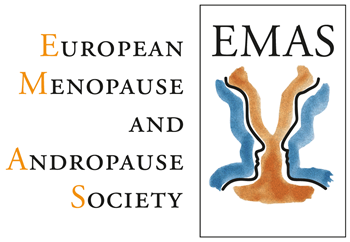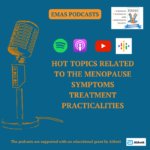Host: Welcome to today’s podcast. Practicalities: Symptoms are getting better, but they’re still there. How to manage those. This episode is part of a podcast series supported by Abbott. The content is solely the responsibility of EMAS, the European Menopause and Andropause Society. All our episodes are available in English, Spanish, Mandarin, and Russian, and you can find them on any of the most popular podcast platforms.
In today’s episode, Professor Dr. Petra Stute, head of the Gynecological, Endocrinology and Menopause Center at the Department of Obstetrics and Gynecology University Hospital Inselspital Bern, Switzerland, and current board member of EMAS will help us understand the practicalities if basal motor symptoms are getting better but are still there.
Dr. Petra Stute: It’s a great pleasure for me to speak for the EMAS podcast series. I’m pretty sure that a lot of you are facing patients that have tried several HRT products and still have vasomotor symptoms. Then you start wondering what you could do with these patients, or maybe you get nervous because you wonder if you have missed something like a more severe disease. What I do first in a woman with persisting hot flashes who has tried several HRT products and who is still sweating, I try to find out what kind of hot flashes she has.
We can differentiate between wet and dry flashes. Menopausal hot flashes usually are wet flashes. Other reasons for having wet flashes are, for example, headaches or migraine, or other neurological conditions. On the other hand, there are dry flashes. Dry flashes, for example, can be associated with certain drugs like antidepressants and protein pump inhibitors. But there are also other medical conditions like hypothyroidism or cancer that can be associated with hot flashes and night sweats. The question at this point is, does the patient have anything else besides just menopausal hot flashes?
Then in the next step, some laboratory workup is necessary. I first measure serum estradiol levels to be sure that the HRT dose she’s taking corresponds well to the expected serum estradiol level. Then we can rule out thyroid dysfunction, kidney and liver diseases, diabetes, and other rare diseases like mastocytosis and pheochromocytoma by blood and urine sampling respectively. After having done all these tests, most likely you will not have found anything specific, which is good because you can tell your patient that she has no serious disease which causes hot flashes. But on the other hand, your patient still has hot flashes. Now you have to make up your mind on what you can offer to her.
There are 4 hypotheses for persisting hot flashes. My first hypothesis is the easiest. I would assume that I would have to increase the estrogen dose and maybe also the mode of application as, for example, you reach more stable serum estradiol levels with oral estrogens in comparison to transdermal estrogens. Sometimes in hysterectomised women, it’s helpful to add some oral micronized progesterone to systemic estrogen therapy. Don’t think it’s forbidden to use micronized progesterone in hysterectomised women. Sometimes this is the solution. Also, I think it’s absolutely fine to combine HRT with alternative treatments, like herbal products or acupuncture, even though there are not enough studies to prove efficacy of these combinations.
My second hypothesis is that the patient may need some androgens, although there is still a debate about if there is an androgen deficiency syndrome in women at all. However, in these cases, I try oral DHEA at 10 to 20 milligrams per day or transdermal testosterone therapy.
My third hypothesis is, that a woman has a combination of different sweating types. It’s possible that on the one hand, she has menopausal hot flashes, and on the other hand, she may have something called primary focal hyperhidrosis. Then, of course, it’s no surprise that the HRT product will not treat primary focal hyperhidrosis at the same time. In these cases, Botox or some anticholinergics like oxybutynin may reduce sweating.
My fourth hypothesis is that the patient may have some kind of vegetative disbalance. In this case, you could combine, for example, St. John’s wort or again, oxybutynin with HRT.
To summarize, for most women who have menopausal hot flashes, it’s absolutely fine to use conventional HRT products. But in some cases, hot flashes are severe or persistent. Then we have to rule out other diseases that may cause hot flashes. If everything is fine, we can adjust the HRT and combine it with other drugs known to reduce sweating. Thank you very much.
Host: Today, Professor Dr. Petra Stute discussed the causes and the diagnostic and therapeutic approach in women with persistent vasomotor symptoms despite hormone replacement therapy. Thank you for listening to today’s episode. We hope it will be valuable for your clinical and research practice. Stay safe.
[END]


